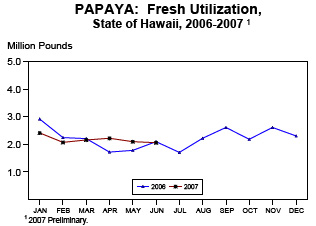Here is the PDF file for the Hawaii Papayas Report.
papaya091307.pdf
Please visit the website for more information: http://www.nass.usda.gov/hi/
————————————————————-
Contact Information:
Mark E. Hudson, Director
USDA NASS Hawaii Field Office
1421 South King Street
Honolulu, HI 96814-2512
Office: (808) 973-9588 / (800) 804-9514
Fax: (808) 973-2909
————————————————————-
“HAWAII PAPAYAS” reports are available on our website and also PRINTED monthly. Subscriptions for PRINTED copies are free to those persons who report agricultural data to NASS (upon request) and available for $4 per year to all others.
JULY FRESH PAPAYA HIGHER
Hawaii fresh papaya utilization is estimated at 2.4 million pounds for July 2007, up 16 percent from last month and 40 percent higher than the same month a year ago. Year-to-date sales for the first seven months of 2007 posted 15.4 million pounds, 5 percent above the comparable period in 2006.
Warm summer weather continued in July, encouraging flowering and fruit set. Tropical Depression Cosme and a weak shear line brought welcomed showers to the State. Normal farming activities were underway. Harvesting was steady. Growers were preparing fallowed fields for new plantings. Wild pig damage and Papaya Ringspot Virus were still affecting some orchards.
Papaya growers are expected to receive an estimated 47.0 cents per pound for fresh fruit in July, 10 percent (5.0 cents) lower than June, but unchanged from a year ago.
2006 Papaya Output Down
In 2006, papaya output totaled 28.7 million pounds, down 13 percent from 2005 and falling for the fifth consecutive year. Weather for 2006 had a mixture of wet and dry conditions. Continuous rain fell during mid-February until early April causing soil erosion, flooding, disease outbreaks, and fruit and tree losses in orchards across the State. It also delayed normal field routines including planting schedules.
The biotechnology variety Rainbow made up 58 percent of total acres in 2006, up 9 percent from 2005. Rainbow is resistant to Papaya Ringspot Virus (PRV), a virus that devastated the Hawaii papaya industry from 1993 to 1999. The Kapoho variety was the standard for the papaya industry for many years; however, Kapoho is susceptible to PRV. Yields of Rainbow are higher during the first year of harvest compared to the Kapoho variety. In the second year of harvest, yields for Rainbow are comparable to the Kapoho variety. Routine field inspections and rogueing of infected trees kept losses to PRV light. The Kapoho variety comprised 25 percent of total acreage compared to 30 percent the previous year. Annual August surveys since year 2000 show Rainbow and Kapoho have been the major two varieties.
The State’s in crop papaya acreage totaled 2,095 down 13 percent from the previous year. Harvested acreage rose 3 percent from 2005 to 1,530 acres, up for the second year.
In 2006, the number of farms totaled 168, declining 19 percent from the 2005.
Hawaii County continues to lead with papaya production and accounting for the majority of the State’s total.
Value of utilization (fresh and processed) for 2006 was pegged at $11.0 million, 2 percent below 2005. Papaya price of 38.5 cents per pound increased 4.3 cents above last year average.
U.S. Papaya Imports Higher
Fresh papaya imports from foreign sources into the United States totaled 291.4 million pounds in 2006, up 14 percent from the previous year, according to the Department of Commerce. Mexico accounted for 201.0 million pounds or 69 percent of the total. Imports from Belize have steadily increased and contributed 26 percent of the total imports in 2006.
Total imports by type for 2006 increased 14 percent from 2005 to 308.6 million pounds due to more fresh papayas. Fresh imports continued to account for the majority or 94 percent of total imports.
World Papaya Production Up 2 Percent
World papaya production totaled 14.9 billion pounds in 2006, up 2 percent from a year ago, according to the Food and Agriculture Organization.
Brazil remained the top producer of papayas growing 3.5 billion pounds. Rounding out the top five producers world wide are Nigeria with 1.8 billion pounds, Mexico with 1.8 billion pounds, India with 1.7 billion pounds, and Indonesia with 1.4 billion pounds.
 JUNE FRESH PAPAYA OUTPUT LOWER
JUNE FRESH PAPAYA OUTPUT LOWER